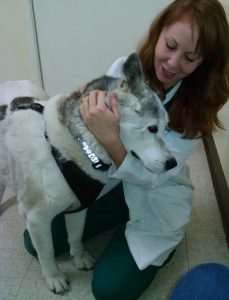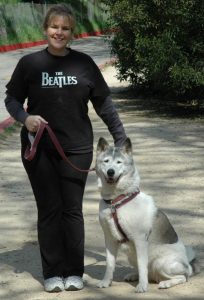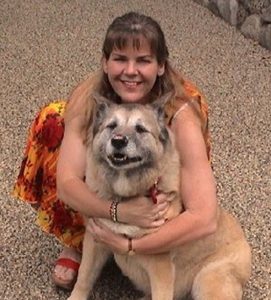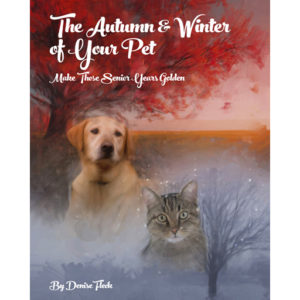
With the ceremonial lighting of candle #7 on the doggie bone or kitty fish birthday cake, it is generally assumed your best friend has emBARKed on his golden years. Giant breeds enter seniorhood around 6 while smaller dog breeds and cats closer to 9. Though often premature to consider your best pal a senior citizen, it’s a great time to make changes that can ensure a continuing quality of life. Decreased activity and loss of muscle tone can result in constipation, arthritis, degenerative joint disease and cognitive dysfunction, so…get those paws moving, but always speak with your veterinarian before starting any new regimen to be sure it is the best course of action for your pet.
Exercise helps maintain healthy body weight – Just as in humans, excess weight in senior dogs may bring about serious health conditions such as diabetes, congestive heart failure and liver issues. Exercise also aids in proper digestion and nutrient absorption which are important to overall health. The best exercise for a cat is adopting a second cat (and we talk all about that in the course mentioned at the end of this article)!
Exercise helps delay the onset of osteoarthritis – We all need our joints to work smoothly and efficiently to get us where we want to go. Moderate exercise can keep movement fluid, slow deterioration and minimize pain.
Exercise helps maintain mental health – Well-oxygenated blood flow to tissues does a body good, and exercise also removes toxins. Activity keeps nutrients like glucose at optimum levels in the brain and like every other organ in the body…the brain requires good nutrition to function properly.
What’s a dog parent to do?
- First, talk to your veterinarian to determine what exercises will be most beneficial and which to avoid. Ask if apoequorin might help with Cognitive Function so that your best friend will remain “in the moment” with you.
- If at any time, your dog gets tired, coughs or has problems breathing, stop and call your vet. You know your dog better than anyone else and know when he is not acting normal. By detecting and treating a problem early, you may save your best friend’s life.
- Remain patient with your older dog and never get frustrated by time needed to acquire a new skill or perform a task. Enjoy each moment together.

What not to do
- Do not let your senior canine exercise for long periods of time or under hot or humid conditions. Most dogs wish to please their owner and will risk their own health to do so.
- Do not force your senior to exercise. If he looks tired or unwilling, call a time-out. Limping, stiffness, lameness, tenderness in limbs and spinal areas are all reason to seek veterinary advice.
- Don’t over-treat during training as older dogs add weight more quickly and lose pounds more slowly due to changes in their metabolism.
According to a team of researchers at the University of Veterinary Medicine in Vienna, “Walking uphill may improve the flexibility of affected joints, particularly of the hip, while walking over low obstacles may improve the bending of the joints in the front and rear limbs.”
While a study in the American Journal of Veterinary Research cautions, “Dogs who have undergone surgery to the tibia, should avoid walking over obstacles which could potentially strain the tendon that joins the knee to the shin.” Choosing the right exercise makes it beneficial as well as fun. Learn what is best for Fido’s sake!
Low impact walking and swimming are great ways to increase mobility. Short 10-15 minute sessions allow your dog to adjust to the routine without becoming tired. Aqua-therapy might be just the key! The combination of water resistance and free-joint movement allows senior dogs to enjoy exercise with no harsh impact on their bodies, and many really love stretching their legs in the pool – supervised of course!
If your dog does not love to swim, choose another activity. Gentle walks during the cooler part of the day can be ideal. Build upon your dog’s existing strengths and interests. One canine will be excellent at fetch and release, another might prefer tug-of-war. “My healthiest senior dogs were flyball veterans,” says KimToepfer of Fresno Dog Training. “They continued to play well into their teens but with lower jump heights and an emphasis on fun rather than speed. The combination of mental and physical stimulation made for a great workout.”
As in any training or exercise program, pay attention to your dog and note if he is enjoying it. Break the activity into small achievable steps and reinforce the skill while encouraging progress.
Consistency is vital for dogs that have lost an important communication tool such as sight or hearing. Use consistent commands or hand signals and be patient if your dog struggles to accommodate his new limitations.
Refresher courses on basic obedience keep an older mind sharp. Take your senior through his “sits,” “stays” and “comes.” Toss in something he never learned before whether it’s that silly “keep the biscuit on your nose” trick or guessing which cup the kibble is under. Old dogs can learn new tricks. Be patient and keep it fun.

Nose work can be great for older dogs since it doesn’t require physical stamina and can be enjoyed even by those losing their sight; It’s a great way to keep the body busy and the mind active without over exerting. And agility isn’t out of the question. Just slow down the speed and limit or leave out the jumps all together.
Whatever you do, do it together and cherish those golden years!

I am waggin’ my tail over the debut of my SENIOR PET CARE CERTIFICATE COURSE! Three-hours of online learning take you on a journey through the autumn and winter years of your pet’s life, showing you the importance of tuning in, letting you know what signs to look for, sharing with you the various ailments and different modalities that could you increase your dog or cat’s quality of life allowing you to continue making PURRfectly wondeRUFFul memories together. Not required, but it is suggested you also get “The Autumn & Winter of Your Pet: Makes Those Senior Years Golden” – ebook FREE with purchase of print version! Scores of 80% and higher on the 36 question multiple choice/True-False exam that follows will receive a Certificate of Completion. Sign up now to make the most of the later years you’ll spend with your furry best friend!

WATCH MY VIDEO VLOG ON THIS TOPIC AT https://youtu.be/rjrZXpFS4eU
________________________________________________________________________________________
Denise Fleck is an award winning author and freelance writer. After extensive training, practice, more training and more practice, she developed her own Pet First-Aid & CPR curriculum and has been teaching animal life-saving skills for close to 20 years with many success stories to share. Additionally she developed a 5 month long Animal Care course for high school students in conjunction with the Burbank Unified School District and Animal Shelter. She has demonstrated animal life-saving skills on CBS –TV’s “The Doctors,” Animal Planet’s “Pit Boss,” “Kirstie Alley’s Big Life” and countless other shows. To complement her teachings, Denise created a line of Pet First-Aid Kits, posters and books for children teaching animal respect and care! Visit www.PetSafetyCrusader.com or call (818) 951-7962.
Note: The articles on this page are copyrighted. Please do not reprint or use portions for any purpose without written permission from the author. Request permission for usage by sending an email explaining how you’d like to use the materials and what parts specifically. Thank you in advance!








